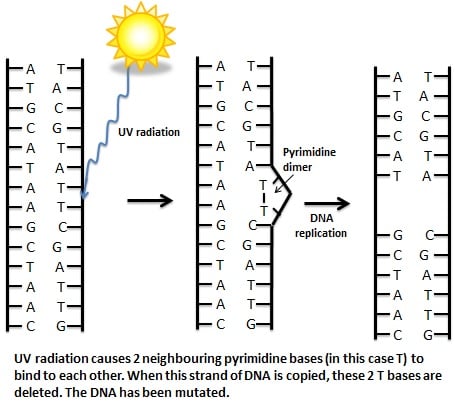The burning red sunburn fades into a ‘healthy’ brown. The pain has subsided and, in the knowledge that your complexion will spark jealousy in your co-workers upon your return, it all seems like it was worth it. But was it?
To follow-up my previous post about how sun cream protects your skin from the Sun’s powerful ultraviolet radiation, I thought I should write one to explain why exactly it is important to use it and the dangerous, cancer-y consequences of prolonged sun exposure. Just to be clear, I am not trying to preach (and, country to popular belief, I don’t work for a sun cream company), I am simply trying to inform you of the fascinating (and potentially deadly) science that takes in your body, in response to UV radiation from the Sun.
So first of all, what is cancer? Cancer is simply your own cells, but they are growing too quickly, forming a tumour. Due to the speed at which they grow, they starve the nearby healthy cells, eventually killing them. Depending on where this happens it can, clearly, be very dangerous.
Most of the cells in your body need to grow and divide all of the time. Damaged or dead cells are continually lost and replaced by new, shiny counterparts, and life goes on. There are two types of genes that control the rate at which cells divide, which can be thought of as the accelerators (the oncogenes – onco basically means cancer) and the brakes (the tumour-suppressor genes). Genes are made of DNA, which is a code of 4 letters, A, T, C and G (see here for a quick review). If any of the letters that make up this code are changed, the gene is said to be mutated, and this can have drastic effects on its function. If an accelerator becomes over-active, and the brakes stop working, the cells begin to divide out of control, and cancer is born.
UV light targets DNA. Specifically it targets the bases T and C, which are known as the pyrimidines. The energy in a beam of UV radiation causes 2 neighbouring Ts and/or Cs to stick together, forming a ‘pyrimidine dimer’. This can no longer fit into the neat, compact double-helix and when the DNA is replicated, these two bases are missed out. The code has therefore changed, it has been mutated. If this mutation occurs within one of the accelerators or breaks, it can change their activity and potentially cause the cells to grow uncontrollably.

Humans have approximately 20000 genes, so the odds of this happening to a specific gene AND the mutation having the required, cancer-causing effect, are clearly very low. The cell is also able to repair most of these mutations, giving us a slightly better chance in the war against ultraviolet. However, the longer the skin is unprotected and exposed to UV light, the more and more likely this becomes.
This said, don’t be afraid of the Sun! You do also need sunlight to remain healthy, and not just in the sense of avoiding being a recluse who lives in the basement, afraid of natural light. This, I do not recommend. Your skin needs to be exposed to some UV light as it is vital for producing vitamin D, which is important for the maintenance of healthy bones. However, the amount of UV radiation required to produce an adequate, bone building supply of vitamin D is much smaller than the amount that causes sunburn.
It is about finding a balance. You need sun exposure for vitamin D production, general happiness and, obviously, that envy-inspiring tan. But, by triggering the formation of pyrimidine dimers, which are subsequently deleted from the DNA sequence, it is able mutate the DNA. When this happens enough times, a tumour-suppressor or oncogene will eventually be affected, leading to uncontrolled growth of the skin cells.
As I said, I am not trying to convince/force you to use sun cream, all I care about is that you know what is happening under your skin, and hopefully find it interesting.

Hey Ben, just been catching up on your blogs – have just read the sun cream one and this one. Really well written and interesting and full of things that I didnt know (the difference between UV-A & UV-B for example)!
Keep it up 🙂
This is good! One thing I always wondered – what exactly are moles? And why do we go freckly in the sun? I’ve got loads of moles on my arms, does that mean I’m at a higher risk of getting skin cancer? I think this has something to do with cell senescence but I never really looked into it. I would do now, but… well I’m on holiday and I don’t really feel much like exerting myself… 😉
Moles are collections of melanocytes, hence their darker appearance. Having more moles does, unfortunately, slightly increase your risk of skin cancer, because they are basically benign tumours. However, men are at higher risk than women, so you can take some solace in that!
So would most sun creams not protect you from UV-A rays?
Also will skin cancer show you symptoms before it gets out of hand?
I could look this up but I rather you tell me o wise Ben
It depends on the sun cream you get. They usually have a star rating on them, which tells you how much protection they give against UV-A. Skin cancer does show symptoms, generally a darker, fast growing spot or mole is a good sign. The problem with skin cancer is it migrates very quickly and can spread around the body if you don’t catch it early.
Really good breakdowns for easy understanding, making this information public knowledge for people to be able to make informed decisions of their own is very important. Great way to do it.
One thing which needs to be understood is also the effect of these UV deflecting and absorbing compounds on the body itself. It’s all well and good to say wearing sun cream will inhibit you from getting skin cancer, but how is the application of benzoates affecting cells internally, benzoates are also known carcinogens.
What skin protection is out there that does not contain harmful components?
Only about 1-10% of sun cream components are absorbed by the skin; however, you are right in saying that some of these are harmful. A few of the UV-absorbing substances in sun cream can damage the cell’s DNA and generate reactive oxygen species, which may also damage the DNA, potentially leading to cancer.
Although these properties have been identified, there has been no conclusive causal link between sun cream and skin cancer, and in fact, several studies have found that, even with these ingredients, the regular use of sun cream significantly reduces the chance of developing skin cancer. If you want to read more, see Ulrich et al., 2009 British Journal of Dermatology 161 pp78–84.
One option if you want to avoid these substances is to use micronized zinc oxide cream, as this is not absorbed by the skin and fully blocks UV-A and UV-B. However, this is not particularly pleasant stuff, and if inhaled could damage your health in other ways. It is also harder to find and more expensive.
I would say that the benefits of using sun cream massively outweigh the risks, so would definitely recommend it to anyone.
Although the benzoates in suncreams are carcinogens themselves!